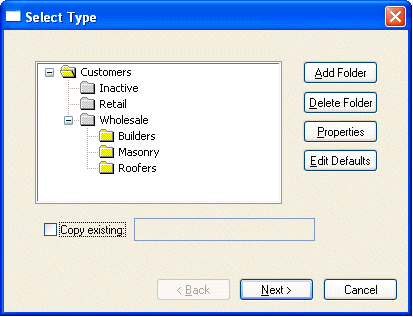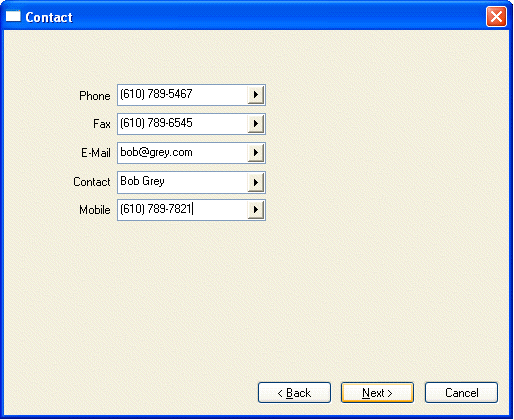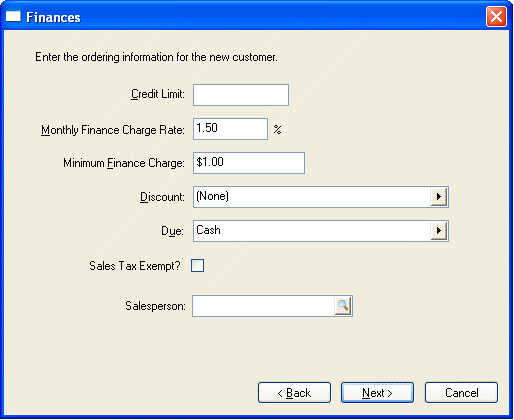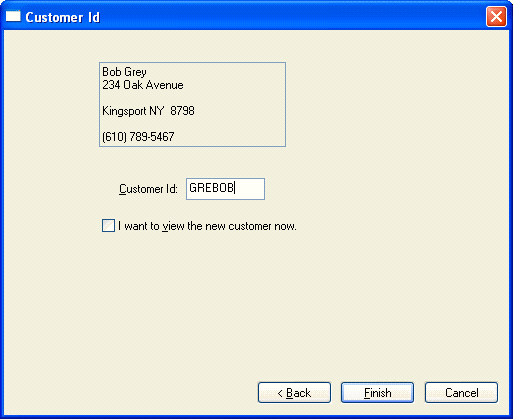
Open the customer list by selecting Customers within the Sales menu (Sales > Customers). It is wise to set customer folder defaults before entering new customers. Review the Setting Customer Defaults section for information on creating default values in this wizard.
Click the Edit menu and select New. A new customer wizard will start taking you through the following steps:

1. Highlight the folder in which you want to place the new customer. Turn the Copy existing switch ON if you wish to copy the new customerís information from another customer account. Review the Adding and Deleting Customer Folders section for more details on creating new folders.
2. Click the Next button to continue. The following window will appear. 
3. In the Name window, enter the customer information in the appropriate fields.
Enter the customerís name and address information in the appropriate fields. Enter a companyís name in the Last Name entry field and let the First Name blank. EBMS creates a zip code database when the user enters a city, state, and zip. If a zip for a particular city and state has been entered before, the zip can be entered and the system will display the corresponding city and state. The zip code list can be viewed or changed by going to File > System Options > Zip Codes tab. Click Next to continue with the next wizard page.

4. Enter the customer Contact information as requested. Click on the right arrow key to the right of the field and select the appropriate field label. Click Next and the following window will appear:

5. Enter the following customer Finances information.
∑ Credit Limit: Enter the maximum credit for this customer. To extend unlimited credit set the Credit Limit to zero.
∑ Set the Monthly Finance Charge Rate that will be charged on overdue invoices. Many companies charge an overdue finance charge rate of 1% to 2% per month. This computes to a total of 12% to 24% annual rates. See the Printing Customer Statements section for more details on processing finance charges.
∑ The Minimum Finance Charge amount is the minimum charge per invoice. If the calculated finance charge for any overdue invoice is less than the Minimum Finance Charge, the finance charge amount will equal the Minimum Charge. Zero this field if you do not wish to set a minimum charge amount.
6. Set the Discount field to list the standard discount, if any, allowed for this customer. To set the discount, perform the following two steps:
a) Set the proper discount template by clicking on the right arrow button to the right of the discount field. A drop down list will display all the discount options. If no discounts are allowed for this customer set the entry field to (none) and ignore the second step.
b) If you have set the discount template, you will need to enter the discount detail information. For example, if you set the option to "__ % paid in __ days" you must enter the discount percentage and the number of days in which the customer is allowed to take the discount.
7. Set the Due terms for this customer. To set this customer as cash select Cash as the Due setting. Otherwise set the Due terms, which requires two steps:
a) Set the template entry by clicking on the right arrow and selecting one of the options. If this field is set to "(none)" the customer will be allowed unlimited terms. The most common term template is "Net __ days". A "Collect on Delivery and Due on Receipt" term setting will cause the sales invoice to be processed as a charge invoice, but will set the due date as immediate.
b) The template may require term details such as a date or number of days. For example, if the "Net __ days" template is selected the exact number of days must be set to complete due date terms.
8. Set the appropriate sales Tax table to be used on the customerís invoice. If the customer is sales tax exempt, set the Tax table field to Exempt. Review the Establishing Sales Tax Rates section for more details.
9. Click the Next button to continue to next page of wizard.

10. Enter the Customer Id. This code is required to be unique to a specific customer. This identification code is used throughout the entire accounting system for all transactions associated with this customer. (Changing the customer Id is a lengthy process Ė plan ahead and utilize an Id that is satisfactory). Example: Customer Name Ė Martinís Auto Body could have a Customer Id of MARAUT. John Roland may have a Customer Id code of ROLJOH. Review the Creating and Changing Ids section for more details.
11. Click Finish to create new customer or Cancel to ignore new entries.
Go to File > Getting Started > System Options > Zip Codes tab to view or change the city, state, and zip code list.
When the above entry is completed for a customer, there may be other customer information that you wish to enter. To view all the customer information, review the Changing Customer Information section .